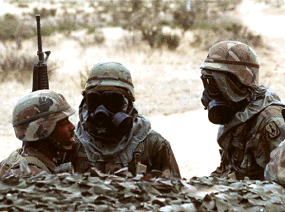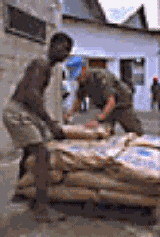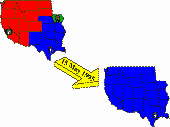![Jerry Hammes.com [Logo]](../../../images/logo.jpg)
|

|
Fifth U.S. Army Patch History
[Back to topic list] [Back to Military - 1953 Topic] The Fifth U. S. Army patch, or shoulder sleeve insignia, was originally approved on April 7, 1943. The patch contains on a red rectangular background with top corners chamfered at 45 degrees, a silhouette of a mosque in blue charged with a white letter "A". The flag colors of red, white and blue are fitting. The outlined figure of the mosque is symbolic of the country in which this Army was originally activated. The letter "A" indicates "Army" and conforms, in general, to designs used by the First and Third United States Armies.  From the Salerno beachhead to the sands of Kuwait, from Rome to Mogadishu, from San Antonio to Los Angeles to Seattle to Des Moines and New Orleans, the soldiers of Fifth U.S. Army have served and are serving their country. Now headquartered at Fort Sam Houston, Texas, Fifth Army's origin can be traced to its birth on foreign soil in World War II. That origin is seen on the shoulder patch worn by Fifth Army soldiers. The blue mosque on the patch is a reminder of the Fifth Army's activation at Oujda, French Morocco, on January 5, 1943.  Fifth Army has a proud record of combat and eventual victory. LTG Mark Clark Initially commanded by Lieutenant General Mark Clark, the new field army immediately began planning its first mission: to carry out an amphibious assault on a hostile and well-defended shore. At dawn on September 9, 1943,Fifth Army executed that mission. In the face of fierce enemy resistance, the soldiers of Fifth Army were from the Active Army, the National Guard and the Army Reserve. Together they battled ashore at Salerno, Italy. Despite a brutal struggle and heavy casualties, America's new field army was victorious. Fifth Army not only became the first American army to initiate combat on the European mainland in World War II but also the first to win a battle on the continent and the first to liberate a European capitol. September 9th continues to be recognized as the Fifth Army's "Unit" or organization date.  The long, hard Italian campaign was only beginning at Salerno. Bitter fighting followed at the Rapido River, at Monte Cassino and at Anzio. On June 4, 1944,units of the Fifth Army entered Rome, making the Fifth the first American Army to liberate a European capital. The Italian campaign continued as Fifth Army battled up the Italian boot, eventually linking up with troops from the Seventh Army on the Austrian-Italian border on May 4, 1945. Fifth Army troops fought continuously for 602 days, a record for sustained combat by any contemporary American field Army. Those 602 days of combat had cost 109,642 American casualties. Of that number, 19,475 had been killed in action.  The place names in that victorious struggle are written bold on the pages of American military history: Anzio, Monte Cassino, the Rapido and Garigliano rivers, the Gustav Line and the Winter Line, as well as towns like San Pietro and Altaville. The story is one of a thousand bitter engagements on hundreds of mountains and valleys. For its service in World War II, the Fifth Army flag carries battle streamers representing the Naples-Foggia, Anzio, Rome-Arno, North Apennines, and Po Valley campaigns. Fifth Army's travail and sacrifice for so many months up-and-down the rocky spine of Italy - through its stalemating mud, swollen rivers, and brutal winters - against a highly professional foe established a standard of selfless service and sacrifice that we honor and cherish. Fifth Army was inactivated in October 1945, then reactivated in June 1946, with headquarters in Chicago, and later at Fort Sheridan, Illinois. On June 30, 1971, Fifth Army and Fourth Army merged at Fort Sam Houston and Fourth Army was inactivated on the next day. The historic Quadrangle became home for Headquarters, Fifth Army, which then had a 14-state area of responsibility (Arkansas, Illinois, Indiana, Iowa, Kansas, Louisiana, Michigan, Minnesota, Missouri, Nebraska, New Mexico, Oklahoma, Texas, and Wisconsin). In 1983, as a result of reorganization, Fifth Army's area was reduced to eight states.  During Operations Desert Shield and Desert Storm in 1990/1991, some 27,000 citizen-soldiers from more than 200 Army National Guard and Army Reserve units in the Fifth Army area were mobilized, many of these deployed to the Persian Gulf. Upon their return, they were given a justly deserved hero's welcome from neighbors who learned, once again, that Reserve Component units are an integral part of America's Army. Other Fifth Army area Reserve Component units remained overseas after the Gulf Conflict, taking part in Operation Provide Comfort relief efforts in northern Iraq. Fifth Army soldiers also served in Somalia, participating in Operation Restore Hope. The Deputy Commanding General of Fifth Army was named the Deputy Commanding General of the Operation Restore Hope joint task force, which initially went to Somalia in December 1992.  Still other Fifth Army soldiers deployed to Mogadishu in the aftermath of the October 3, 1993, battle between U.S. Army forces and Somali militia and served there for several months. In 1995, the Deputy Commanding General of Fifth Army was named Commander of United Nations Forces in Haiti.  In 1995 the Continental U.S. Armies (CONUSAs) were realigned. Since then there are two CONUSAs (First and Fifth U.S. Armies). Fifth Army's area of responsibility (AOR) increased from 8 to 21 states - all states west of the Mississippi River, except Minnesota. This AOR encompasses more than two million square miles and a population of approximately 100 million. In 1997, Fifth Army assumed the mission of response to Weapons of Mass Destruction incidents for its area of responsibility. When directed, Fifth Army deploys Response Task Force-West to support the Lead Federal Agency during a Weapons of Mass Destruction incident in United States Atlantic Command's area of responsibility; assumes Operational Control of committed DOD elements, less Joint Special Operations Task Force, and re-deploys upon meeting DOD support termination criteria. In October 1999, under the Army's new integrated force concept, two Training Support Divisions will be under the operational control of Fifth Army. These integrated divisions have administrative control over all training support brigades and battalions in their areas of responsibility. |
 |
 |
 |
 |
 |
 |
 |
 |